Glucocorticoids are among the most widely prescribed drugs in the world. Applications for this class of drug have grown over the decades. So too has an awareness of the dangers they present...both to humans who take them, and to animals that absorb them because the drugs have leached into the environment.
Ptereleotris Zebra Fish:
Affected by Glucocorticoids in the Environment
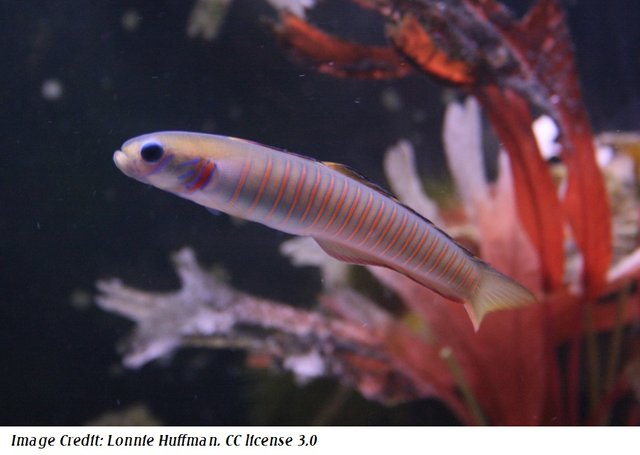
Observed changes:
In a controlled study, five glucocorticoid formulations were introduced. Overall, some of the changes noted in the fish: liver chemistry, which influences circadian rhythm, glucose metabolism and immune response; the upregulation and down regulation of certain chemicals by the brain; decrease in the number of mature oocytes.


In 1948, cortisone was used successfully, for the first time, to treat a patient with rheumatoid arthritis.Today, the class of drugs to which cortisone belongs, glucocorticoids, has become the mainstay of treatment for between 56-68% of patients who have rheumatoid arthritis.
Glucocorticoids--GCs--are involved in a number of vital life processes. They help to control: metabolism, electrolyte balance, immune system function, mood stability, cognition, reproduction, cardiovascular system and growth. So, an excess or deficit of GCs can have a devastating effect on well-being, and even survival.

While GCs were first used to treat rheumatoid arthritis, it was discovered over time that they were powerful anti-inflammatories
and could be helpful in a number of conditions. It is likely that
readers of this post have used some form of GC. These medicines are
prescribed to alleviate skin rashes, eye inflammation, asthma,
bronchitis and a host of other maladies, including serious autoimmune
diseases. GCs are even useful in the treatment of some cancers and, in certain circumstances, acute bouts of flu.



Rosy Red Fathead Minnows
Undergo Changes Related to Glucocorticoid Exposure in Controlled Experiments
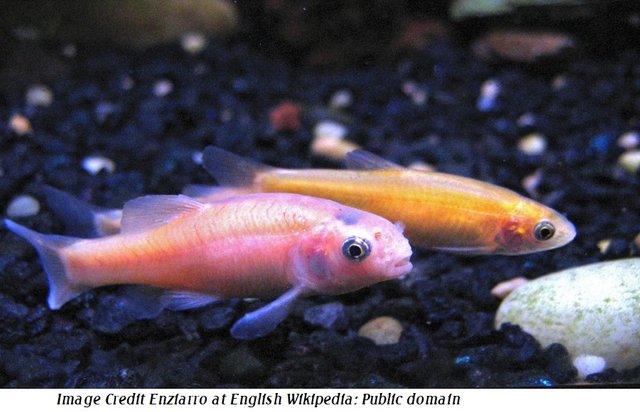
Some observed changes:
Decrease in the number of lymphocytes, plasma glucose increased, and female fish developed secondary sexual characteristics.

Glucocorticoids and the HPA Axis

The therapeutic effect of GCs resides in the role they play in what is known as the HPA Axis. This is a coordinated interaction between the hypothalamus, pituitary gland and adrenal glands.
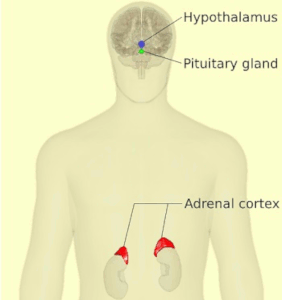
The hypothalamus receives a message that the body is under stress. The hypothalamus then releases a hormone, corticotropin-releasing hormone (CRH), and sends that hormone to the pituitary gland. The pituitary gland responds by releasing its own hormone, adrenocorticotropic hormone (ACTH). As this name suggests, ACTH is sent to the adrenal glands--two glands that sit on top of the kidneys.
ACTH instructs the adrenal glands to release cortisol--a powerful glucocorticoid. Cortisol goes to work on a number of body systems to deal with the stress condition. Some of the things that happen are: glucose levels are increased; blood pressure is increased; and blood glucose levels available to the brain are increased. The body is in alert status to deal with a stressful situation.

Brown Trout: Affected by Glucocorticoids in Controlled Experiments
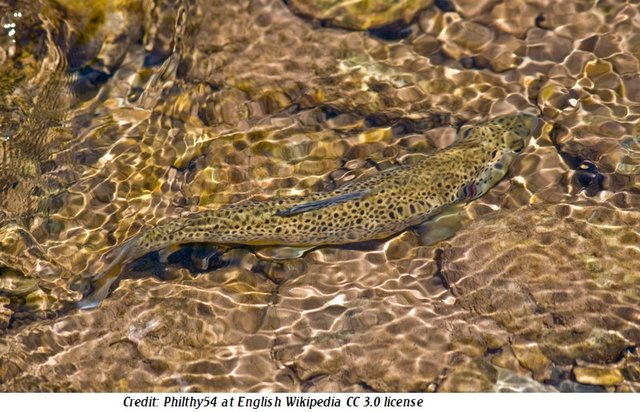
Observed Changes
"... significant decrease in growth rate..." which varied with different levels of exposure.

Turn It Off!!!
Because of all the changes instigated by release of cortisol, there
has to be a point at which this accelerated flow of hormones stops. The
signal to stop occurs when cortisol reaches a certain level in the
bloodstream. The hypothalamus and the hippocampus receive this signal
and begin to end the hormone surge.

Hippocampus (Marked in Red)
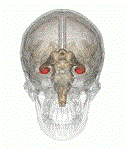
Credit: Life Sciences Databases, CC-BY-SA-2.1 license

Cortisol is always present in the bloodstream of a healthy person. It is released in a steady daily rhythm, which peaks in early morning and wanes in the evening. In some conditions, there is too much cortisol...chronically stressed people, for example, may have elevated levels. And there are some conditions in which there is insufficient cortisol. This is the case in Addison's Disease. A deficiency also can result from long-term therapy with GCs.

Fish Get Stressed and Release Cortisol
It turns out, fish have a stress axis, also: the HPI axis. In this axis, the hypothalamus, pituitary gland and interrenal tissue coordinate to release cortisol when a fish is stressed. Recent research has shown that one way to assess long-term stress levels in fish is to measure the amount of cortisol that has accumulated in their scales.
As is true in mammals, cortisol plays a vital role in many life processes of fish.

HPI Axis in Fish
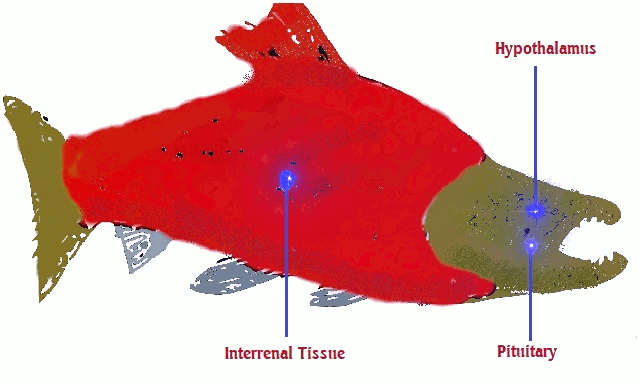


Salmon: research has shown that fluctuating levels of cortisol play a
role in the life cycle of migrating salmon. Young salmon leaving
spawning grounds show spikes in cortisol
as they imprint their surroundings on their olfactory systems. It is
essentially through their olfactory system that salmon will find they
way back to the spawning grounds later in life.



Another example of cortisol in the fish life cycle may be seen in the bluebanded goby. Bluebanded gobies mate in pairs. The female lays the eggs and the male cares for them. Depending on circumstances, male can become female and female can become male. And, unlike many sex-changing fish, bluebanded goby sex transition can be bidirectional.
Cortisol plays a significant role in this transition. Higher levels of cortisol suppress feminization and enhance masculinization.
Bluebanded Goby
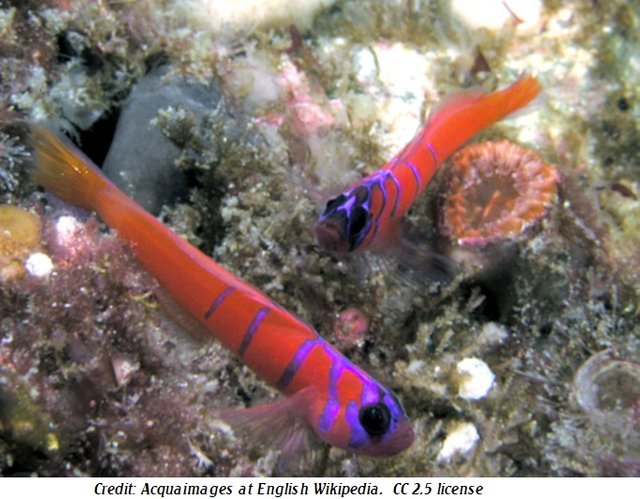


It is because GCs play a vital role in fish development and behavior, that scientists have been looking at the amount of these hormones present in water systems. For example, a 2007 study published in Environmental Science Technology reported that sewage discharge in China contained various concentrations of "prednisone, prednisolone, cortisone, cortisol, dexamethasone, and 6α-methylprednisolone"--all synthetic glucocorticoids.



Another study, from the Netherlands, showed "...high glucocorticogenic activity in waste waters collected at various sites..."
And in yet another study, Japanese researchers found significant presence of glutococoricoids in effluence. Concentrations varied by season and/or water temperature.

In Summary
In 2012, Scientific Reports
published a study that looked at glucocorticoids discharged into water
systems. The findings of this study will serve as a summary for my
blog. Researchers found:
..."previously unrecognized glucocorticoid activity in 27%, and androgen
activity in 35% of tested water sources from 14 states in the US.
Steroids of both classes impact body development, metabolism, and
interfere with reproductive, endocrine, and immune systems. This
prevalent contamination could negatively affect wildlife and human
populations."










Image Sources not Otherwise Credited
Fish Diagram:
Frontiers in Endocrinology
Sam Lin
Pixabay

Fish for GIFs  joakant on Pixabay
joakant on Pixabay

Pulsating light GIF darksouls on Pixabay

Sewage Treatment Plant
wafr onPixabay

End Picture, Seascape Bora Bora on Mariamichelle on Pixabay

Selected Sources Used in Writing This Blog
Science Direct: Glucocorticoids
Science Direct: Effects of the glucocorticoid clobetasol propionate and its mixture with cortisol and different class steroids in adult female zebrafish
Annals of the New York Academy of Science: Fifty years of experience with cortisone therapy in the study and treatment of rheumatoid arthritis
Science Direct: Neuroscience,Glucocorticoids
Frontiers in Immunology A General Introduction to Glucocorticoid Biology
Advances in Experimental Medicine and Biology Glucocorticoids and Cancer
American Laboratory Effective Treatment Strategy for Cytokine Storm in Severe Influenza
Environmental Science Technology Metabolic and reproductive effects of relatively low concentrations of beclomethasone dipropionate, a synthetic glucocorticoid, on fathead minnows
Neuroscientifically Challenged HPA Axis
StatPearls (Internet) Physiology, Cortisol
Journal of Experimental Biology Short-term and long-term effects of transient exogenous cortisol manipulation on oxidative stress in juvenile brown trout
Mayo Clinic Addison's Disease
Integrative and Comparative Biology Cortisol and Pacific Salmon: A New Look at the Role of Stress Hormones in Olfaction and Home-stream Migration
Oceana Bluebanded Goby
Blue Planet Incredible Sex Changing Fish
Frontiers in Neuroscience Stress and serial adult metamorphosis: multiple roles for the stress axis in socially regulated sex change
Environmental Science Technology Occurrence of Natural and Synthetic Glucocorticoids in Sewage Treatment Plants and Receiving River Waters
ACS Publications High-Resolution Mass Spectrometric Identification and Quantification of Glucocorticoid Compounds in Various Wastewaters in The Netherlands
Environmental Toxicology and Chemisty Occurrence of glucocorticoids discharged from a sewage treatment plant in Japan and the effects of clobetasol propionate exposure on the immune responses of common carp (Cyprinus carpio) to bacterial infection
Scientific Reports Prevalent Glucocorticoid and Androgen Activity in US Water Sources
Frontiers in Neuroscience Fluoxetine Exposure During Sexual Development Disrupts the Stress Axis and Results in Sex- and Time- Dependent Effects on the Exploratory Behavior in Adult Zebrafish Danio rerio
Medical Clinics of North America Steroids and the Surgical Patient
The FASEB Journal Gene profiling reveals unknown enhancing and suppressive actions of glucocorticoids on immune cells
Critical Review in Toxicology The hypothalamic-pituitary-thyroid (HPT) axis in fish and its role in fish development and reproduction
Critical Review in Toxicology General background on the hypothalamic-pituitary-thyroid (HPT) axis
Reviews in Fisheries and Science and Aquaculture Maternal Thyroid and Glucocorticoid Hormone Interactions in Larval Fish Development, and Their Applications in Aquaculture
Frontiers in Endocrinology Stress Effects on the Mechanisms Regulating Appetite in Teleost Fish